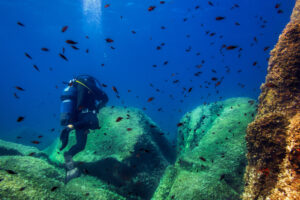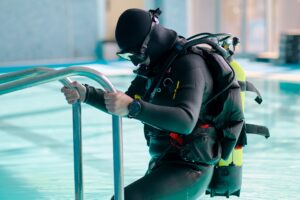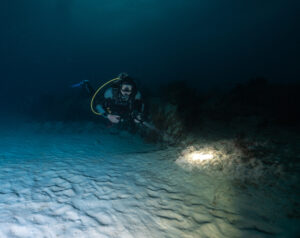What is a Wet Pot?
A Wet Pot is a specialized water-filled hyperbaric chamber used predominantly in experimental work, training, and as a transfer chamber in saturation diving systems. These chambers play a crucial role in the field of hyperbaric operations and scuba diving by providing a controlled environment for divers and researchers. In training scenarios, Wet Pots simulate underwater conditions, allowing divers to practice and prepare for real-life situations. In experimental contexts, they enable scientists to conduct research on the effects of pressure and gases on the human body and various materials. Furthermore, Wet Pots serve as transfer chambers in saturation systems, where they facilitate the safe removal and handling of wet equipment after deep dives. Their versatility and utility make Wet Pots an essential component of modern diving and hyperbaric practices.
Definition and Description
A Wet Pot is essentially a hyperbaric chamber filled with water, designed for multiple purposes within the diving and hyperbaric communities. These chambers are integral to both experimental work and training due to their ability to replicate underwater pressure conditions accurately. Typically, Wet Pots are cylindrical or spherical in shape and constructed from materials capable of withstanding high pressures, such as steel or reinforced composites. Inside the Wet Pot, conditions can be adjusted to simulate different depths and pressures, allowing divers to experience the effects of these variables in a controlled setting.
In saturation diving operations, Wet Pots are used as transfer chambers. Saturation diving is a technique that allows divers to stay at depth for extended periods by saturating their tissues with inert gases like helium. When divers return to the surface, they use a Wet Pot to transition from the diving bell to the habitat or decompression chamber. This process is critical for managing the physiological stresses associated with changes in pressure and ensuring the divers’ safety.
Key characteristics of Wet Pots include their pressure control systems, which regulate the internal environment to mimic various underwater conditions. These systems often feature sophisticated monitoring equipment to track temperature, pressure, and gas composition, ensuring the safety and well-being of the occupants. Wet Pots also include communication systems to maintain contact with external operators, enabling real-time adjustments and emergency responses if needed.
Historical Development
The concept of the Wet Pot has evolved significantly since its inception, with early versions dating back to the mid-20th century. Initially, Wet Pots were rudimentary in design, focusing primarily on providing a pressurized environment for experimental purposes. These early chambers were often bulky and limited in functionality, but they laid the groundwork for the sophisticated Wet Pots used today.
The 1960s and 1970s saw significant advancements in hyperbaric technology, driven by the expanding needs of the commercial diving industry and scientific research. During this period, Wet Pots became more refined, incorporating advanced materials and engineering techniques. The development of saturation diving techniques further spurred the evolution of Wet Pots, as the demand for reliable transfer chambers grew. This era also witnessed the integration of more sophisticated monitoring and control systems, enhancing the safety and efficacy of Wet Pots.
One of the most notable milestones in the development of Wet Pots was their adoption by the military for training and experimental purposes. The ability to simulate underwater conditions accurately was invaluable for preparing divers for complex underwater missions and studying the physiological effects of prolonged exposure to high pressures. This period also marked the beginning of collaborations between military and civilian researchers, leading to further innovations in Wet Pot design and functionality.
Types of Wet Pots
There are primarily two types of Wet Pots: those used for experimental and training purposes and those employed as transfer chambers in saturation systems. Each type serves distinct functions and is designed with specific features to meet its intended use.
Experimental Wet Pots are utilized extensively in research and training. These chambers allow scientists to conduct controlled experiments on the effects of pressure, gases, and underwater conditions on various subjects, including humans, animals, and materials. Experimental Wet Pots are equipped with advanced monitoring and control systems to ensure precise regulation of environmental conditions. In training scenarios, these chambers provide divers with a safe and controlled environment to practice and hone their skills, preparing them for real-world diving operations.
Transfer Wet Pots in saturation systems play a crucial role in commercial and professional diving. Saturation diving involves divers living in a pressurized environment for extended periods, minimizing the need for frequent decompression. Transfer Wet Pots are used to move divers from the diving bell to the habitat or decompression chamber, allowing them to remove their wet equipment and acclimate to the pressurized environment. These chambers are designed to facilitate the safe handling of equipment and personnel, ensuring smooth transitions and reducing the risk of pressure-related injuries.
Applications of Wet Pots
Wet Pots have a wide range of applications, making them invaluable tools in various aspects of diving and hyperbaric operations. In training and simulation, Wet Pots provide divers with a realistic environment to practice and prepare for underwater missions. The ability to simulate different depths and pressures allows divers to experience the conditions they will encounter in the field, enhancing their readiness and confidence. Training in Wet Pots also helps divers develop essential skills, such as buoyancy control and emergency procedures, in a controlled and safe setting.
In research and experimental contexts, Wet Pots are used to study the effects of pressure and gases on the human body, marine life, and materials. Scientists conduct experiments to understand how different variables impact physiological and biological processes, contributing to advancements in diving medicine and safety. For example, researchers may study decompression sickness, nitrogen narcosis, and the effects of long-term exposure to high-pressure environments. Wet Pots also enable the testing of new diving equipment and technologies under simulated underwater conditions, ensuring their reliability and safety before deployment.
In saturation diving operations, Wet Pots are essential for managing the logistics of deep-sea missions. Saturation diving allows divers to stay at depth for prolonged periods, reducing the need for repeated decompression. Transfer Wet Pots facilitate the safe and efficient movement of divers and equipment between the diving bell and the habitat or decompression chamber. This process is critical for maintaining the health and safety of divers, as it minimizes the risks associated with rapid pressure changes and ensures proper handling of wet equipment.
Safety Considerations
Safety is paramount in the operation of Wet Pots, given the high-pressure environments and potential risks involved. To ensure the well-being of divers and researchers, strict safety protocols and procedures are implemented during Wet Pot operations. These protocols include thorough pre-dive briefings, regular equipment inspections, and constant monitoring of environmental conditions within the chamber.
Common safety measures in Wet Pot operations include the use of redundant systems to prevent equipment failures and the implementation of emergency procedures to address potential hazards. For example, oxygen and gas levels are carefully regulated to prevent hypoxia or hyperoxia, and communication systems are maintained to ensure constant contact between the Wet Pot occupants and surface operators. Additionally, personnel operating Wet Pots receive specialized training to handle emergencies and perform necessary maintenance tasks.
Potential risks associated with Wet Pot operations include decompression sickness, barotrauma, and gas toxicity. To mitigate these risks, divers undergo rigorous training and adhere to strict decompression schedules. Medical support is also readily available to address any health issues that may arise during or after Wet Pot operations. Regular drills and simulations are conducted to prepare for emergency situations, ensuring that all personnel are equipped to respond effectively.
Technological Aspects
The design and operation of Wet Pots involve a range of advanced technologies that enhance their functionality and safety. Key technologies include sophisticated pressure control systems, environmental monitoring equipment, and communication networks. These technologies work together to create a controlled and safe environment within the Wet Pot, allowing for precise regulation of pressure, temperature, and gas composition.
Pressure control systems are at the heart of Wet Pot technology, enabling operators to simulate various underwater conditions. These systems use compressors, valves, and sensors to maintain the desired pressure levels and ensure stability within the chamber. Environmental monitoring equipment, such as temperature and gas sensors, provides real-time data on the internal conditions of the Wet Pot, allowing for immediate adjustments if necessary. This monitoring is crucial for maintaining the safety and comfort of the occupants.
Communication systems are another vital component of Wet Pot technology. These systems facilitate continuous communication between the Wet Pot occupants and surface operators, ensuring that any issues or emergencies can be promptly addressed. Modern Wet Pots often incorporate wireless communication technologies, enhancing the reliability and clarity of interactions. Additionally, many Wet Pots are equipped with video surveillance systems, allowing operators to visually monitor the activities and conditions inside the chamber.
Maintenance and operational requirements for Wet Pots are also significant, involving regular inspections, testing, and servicing of equipment. Ensuring the integrity of the chamber and its systems is critical for preventing failures and maintaining safety. Operators follow detailed maintenance schedules and protocols, addressing any wear and tear or potential issues before they escalate.
Comparisons with Other Hyperbaric Chambers
Wet Pots differ from other types of hyperbaric chambers, such as dry hyperbaric chambers, in several key ways. One of the primary differences is the presence of water within Wet Pots, which allows for the simulation of underwater conditions. In contrast, dry hyperbaric chambers are filled with air or other gases and are used primarily for medical treatments, such as hyperbaric oxygen therapy, and certain types of training and research that do not require an aquatic environment.
The advantages of Wet Pots include their ability to provide a realistic simulation of underwater conditions, making them ideal for diver training and research. The presence of water allows divers to practice buoyancy control, equipment handling, and other skills in an environment that closely mimics real diving conditions. Wet Pots are also valuable for conducting experiments on the effects of pressure and gases on submerged objects and organisms.
However, Wet Pots also have some disadvantages compared to dry hyperbaric chambers. The presence of water adds complexity to the design and operation of the chamber, requiring additional systems for water circulation, filtration, and temperature control. Wet Pots are also typically more expensive to construct and maintain due to the added infrastructure and technological requirements. In situations where water simulation is not necessary, dry hyperbaric chambers offer a simpler and more cost-effective alternative.
Wet Pots are preferred over other types of hyperbaric chambers when the simulation of underwater conditions is essential. This includes scenarios such as diver training,
research on the physiological effects of pressure changes in an aquatic environment, and the handling of wet equipment in saturation diving operations. In contrast, dry hyperbaric chambers are used primarily for medical treatments and certain types of research where an aquatic environment is not required.
Notable Examples
There are several notable examples of Wet Pots in use today, highlighting their importance in various fields. Prominent organizations and institutions that utilize Wet Pots include commercial diving companies, military training facilities, and research institutions. These Wet Pots are often equipped with state-of-the-art technology and are used for a wide range of applications, from diver training to advanced scientific research.
One famous example is the Wet Pot used by the U.S. Navy for training Navy SEALs and other special operations personnel. This facility allows trainees to experience and adapt to the conditions they will encounter during underwater missions, providing a critical component of their preparation. The U.S. Navy’s Wet Pot is equipped with advanced monitoring and control systems, ensuring the safety and effectiveness of the training exercises.
Research institutions also utilize Wet Pots for experimental purposes. For example, marine biology research centers use Wet Pots to study the effects of pressure on marine organisms, contributing to our understanding of deep-sea ecosystems. These research Wet Pots are designed to replicate the high-pressure conditions found in deep ocean environments, allowing scientists to conduct experiments that would be impossible in traditional laboratory settings.
In the commercial diving industry, companies use Wet Pots as part of their saturation diving operations. These Wet Pots facilitate the safe transfer of divers and equipment between the diving bell and the habitat, ensuring the efficiency and safety of deep-sea missions. Notable commercial diving companies with advanced Wet Pot facilities include Subsea 7 and TechnipFMC, both of which are leaders in the field of underwater engineering and construction.
Key Takeaways
Wet Pots are specialized water-filled hyperbaric chambers used in various applications, including diver training, scientific research, and saturation diving operations. Their ability to simulate underwater conditions makes them invaluable tools for preparing divers and conducting experiments. The evolution of Wet Pot technology has led to significant advancements in safety and functionality, with modern Wet Pots incorporating advanced pressure control, monitoring, and communication systems. Despite their complexity and cost, Wet Pots provide unique capabilities that are essential for specific training and research scenarios, distinguishing them from other types of hyperbaric chambers.

















